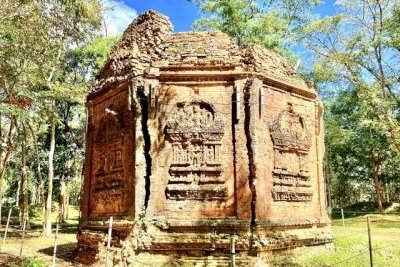
I was fortunate to join ICOMOS international experts two weeks field trip to Cambodia and Thailand exploring pre-Angkorian and Dvaravati arts and Sambor Prei Kuk was one of the many highlights of this trip. To understand this World Heritage Site’s Outstanding Universal Value, we first visited Phnom Da and Angkor Borei, which is on tentative list, to see how Southern Indian art and architecture influenced the area which was Funan Kingdom. After Chenla Kingdom or Ishanapura annexed Funan and built Sambor Prei Kuk, one of the greatest moments on art developments of Southeast Asia happened when the art of Southern India was developed into local style.
There are two major art styles at Sambor Prei Kuk, Sambor Prei Kuk and Prei Kmeng, the latter one I never heard or mentioned in the ICOMOS report so I asked those experts and got insight answer that the nomination dossier of Sambor Prei Kuk was intentionally omitted middle and late Sambor Prei Kuk art history to avoid more comparative studies since Prei Kmeng art can be found in Angkor and other similar period of art development in other sites, even though Prei Kmeng in expert eyes is the apogee of this World Heritage Site’s development. Since the trip was quite in depth, we only saw four temples during our four and a half hours in this archaeological site. The first one was Prasat Sambor group, the main temple still preserved elements of pure southern Indian art, despite its old age the intricate of brick ornamental motif of “Sky Palace” that adorned next to the doors, was incredibly Indian. Since the archaeologists cannot find evidence of art or craftmanship development in other temples, the sudden appearance of Sambor Prei Kuk’s elaborate art style caused many historians to believe that all artisans were imported from India via ancient maritime trade routes. The highlight of Prasat Sambor group is the well-preserved small satellite temples especially the octagonal one with superb motifs in all of its sides, the oldest of its kind that make Sambor Prei Kuk’s art special.
The next one was Prasat Tao group, this one was built in Prei Kmeng. The most obvious features are two lions at the gate and the octagonal colonnades that supporting the lintel, this octagon was quite important as before Prei Kmeng, all temple colonnades were made in round shape. Another important thing is the details of lintel, the Sambor Prei Kuk style is more intricated but also too Indian, Prei Kmeng one is more simplify by reducing details and set the standard pattern of later lintel art of Angkor Wat. After Prasat Tao, we walked into the jungle to see another small temple which I could not fine the name, to see another Prei Kmeng styled lintel. Then we went to Prasat Yeay Poan complex, in my opinion this group was the best for untrained eyes. The first highlight was the brick carved bas-relief medallions on the surrounding wall, again the first of its kind and the forefather of wall decoration of later Angkorian temples. The whole temple was built in Sambor Prei Kuk style like Prasat Sambor group but more details and grandeur. Again, the highlight turned out to be those smaller octagonal temples since each side of these pagodas are decorated with beautifully crafted ornamental motifs of Sky Palace of Hindu gods.
With many time-consuming discussions among arts experts and preservation professionals, we did not have time to stop and see other smaller temples especially the covered by huge tree one that quite popular among photographers, but at least I saw it from the coach. In my opinion, Sambor Prei Kuk is very interesting in art history, undeniable that with load of information from ICOMOS experts helped me to appreciate this site deeply especially its value on cultural transition from India to ancient Khmer Empire. If I did not come with these scholars, I doubt that my idea on Sambor Prei Kuk will be just another old temple and probably only focus on its history as capital city of Chenla Kingdom. Another thing I got from this trip is that my view on Angkor Wat and Banteay Sri as the zenith of Khmer arts are completely wrong, the arts and craftmanship of pre-Angkorian periods are much better and that I would love to see all pre-Angkorian sites to be listed as World Heritage Sites in the future.
More on
Comments
No comments yet.
